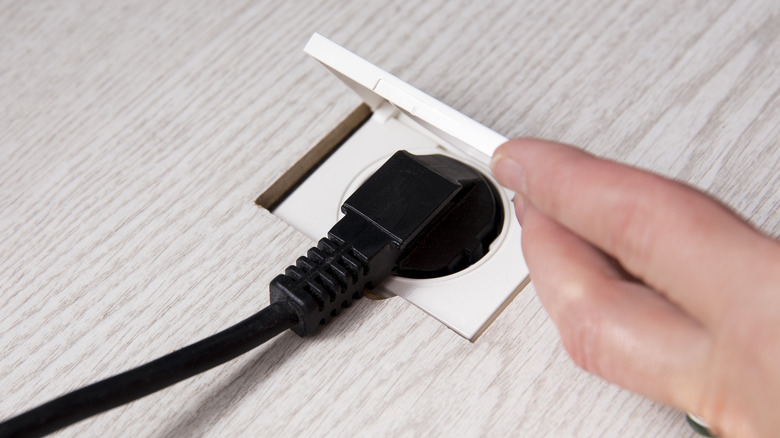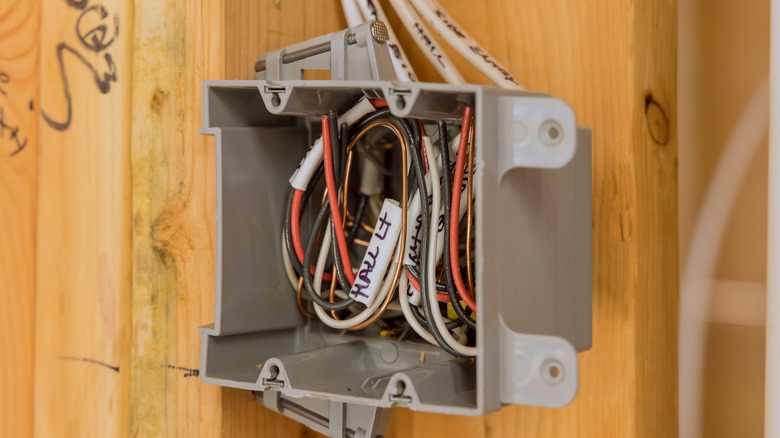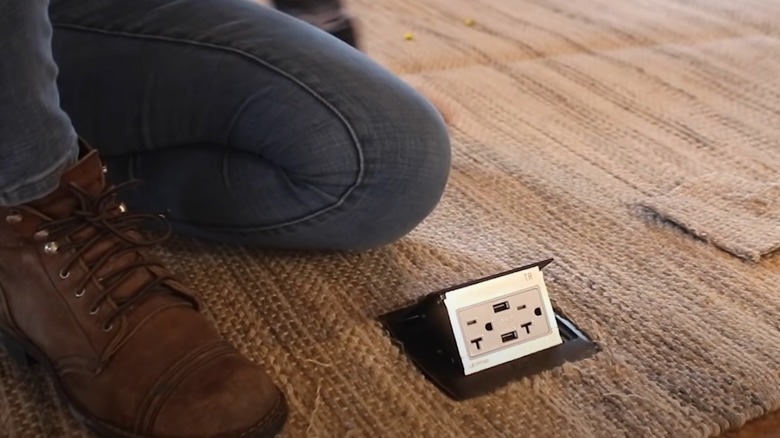The Floor Outlet That Can Disappear In A Flash For That Sleek Aesthetic (And How To DIY)
There are plenty of advantages to having an open floor plan, giving your family the ability to enjoy spending time with each other, even when they're working on different tasks or hobbies. By removing walls, it gives the living area an unrestricted feeling. However, when you lose the walls, you discover one of the reasons why you might want to avoid an open floor plan.
You lose access to electrical outlets commonly found inside walls. At a time when everyone has a mobile device — or two or three — to charge, it's important to have plenty of outlets. One option is to add a poke through an electrical outlet on the floor. You can hide the outlet when it's not in use with a cover, meaning it won't distract from the feel you're trying to capture in the room.
Although you could simply run extension cords from the existing walls to areas anywhere in the open floor plan, this can create a tripping hazard for people as they move. The hidden floor outlet is highly convenient. You can even walk on it without worrying about falling through the floor, and you can mop vinyl or hardwood directly over the top of the cover without worry. You can even place it inside a room that has carpeting.
The cost to have a pro install one of these outlets for you can be up to $300. You can save some money by doing at least part of the installation work on your own.
Safety considerations when installing an in-floor electrical outlet
Any time you are going to work with the wiring in your home, you have to be constantly aware of the dangers that electrical power can bring about. Above all else, you need to be certain that the wires you're working on don't have power actively going through them. Electrocution or electrical shock is possible any time you are working on your home's wiring.
Should you make an error in connecting the wires or in doing the installation, you could cause an overload on the electric box or on the wiring in your home, which could lead to a fire. If you don't have much experience with wiring, electricians would not recommend doing this as a DIY job. Having this job done right is worth a little extra money for the peace of mind that it provides.
If you have concerns about your ability to do the wiring for your poke-through floor outlet, you could do the installation work for the outlet yourself and hire a professional to actually hook up the wiring. The pro can handle any local permitting regulations if required. If you choose to do the wiring work yourself, make sure to shut off the power at the circuit box. Always test any existing outlets and wiring with a voltage tester before touching them. Make sure you're using the correct gauge of electrical wiring for the outlet and for what open space is available in your circuit box.
How to install an in-floor electrical outlet
It's best to purchase a kit to install a poke-through floor outlet. It should have the electrical box, the outlet, the cover, and the hardware you need. You just have to supply the wiring and the tools to install it. It should fit flush with the surface of the floor. This kit should cost $50 to $100.
Start by selecting the location for the installation. Pay attention to your furniture layout and traffic patterns and avoid conflicts with them. Additionally, check out the unfinished basement or crawl space under the proposed location, as you need to run wiring in these areas to connect the outlet. Even if the space underneath has a finished ceiling, you can do the installation, but it's challenging to run the wiring.
Once you've selected the location, you can begin by cutting the hole in the floor. Cut away the carpet and foam, if necessary. Drill a pilot hole. Then, use a hole saw with a diameter that matches the box size. If the box is rectangular, you'll need a jigsaw to cut the hole to match the size of the box. Next, run the wiring from the circuit box to the location of the in-floor outlet.
You could also tie into an existing electrical outlet close to the new outlet. Connect the wiring to the box, drop it into the hole, and mount it in place. Finally, attach the cover plate for the new outlet.


